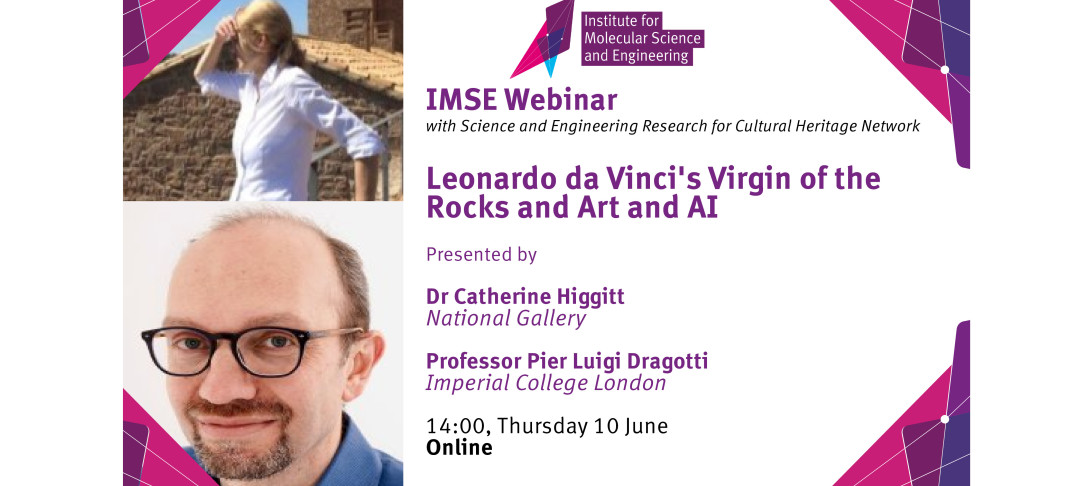
This webinar will be held on zoom. The structure of the event will be two 20 minute presentations followed by audience Q&A. Please register to be sent the joining instructions. You can pre-submit questions for the Q&A section when registering.
This webinar is part of the series
Science & Engineering Research for Cultural Heritage
The theme discussed in this webinar will be:
Leonardo da Vinci’s Virgin of the Rocks and Art and AI
Biography
Dr Catherine Higgitt
Principal Scientist at the National Gallery
Catherine Higgitt has a PhD in chemistry (University of York) and joined the Scientific Department in 1999 as an organic analyst, specialising in the study of paint binding media using a combination of spectroscopic and chromatographic techniques. Between 2007 and 2015 she was Head of Science at the British Museum, gaining experience working with a wider variety of materials and handling data acquired using a very broad range of analytical and imaging techniques. In 2015 she returned to the National Gallery as Principal Scientist, helping extend the range of analytical and imaging approaches available for the study of paintings. As the majority of methods she employs, whether on micro-samples or in-situ on paintings generate 3D datacubes she is increasingly concerned with how best to interrogate, interpret and present this data and possibilities to combine datasets to enrich understanding. She has extensive experience in the application and publication of her research for different academic audiences, including both art-historical and scientific, as well as the wider public.
Professor Pier Luigi Dragotti
Professor of Signal Processing in the Electrical and Electronic Engineering Department at Imperial College
Pier Luigi Dragotti is Professor of Signal Processing in the Electrical and Electronic Engineering Department at Imperial College London and a Fellow of the IEEE. He received the Laurea Degree (summa cum laude) in Electronic Engineering from the University Federico II, Naples, Italy, in 1997; the Master degree in Communications Systems from the Swiss Federal Institute of Technology of Lausanne (EPFL), Switzerland in 1998; and PhD degree from EPFL, Switzerland, in April 2002. He has held several visiting positions. In particular, he was a visiting student at Stanford University, Stanford, CA in 1996, a summer researcher in the Mathematics of Communications Department at Bell Labs, Lucent Technologies, Murray Hill, NJ in 2000, a visiting scientist at Massachusetts Institute of Technology (MIT) in 2011 and a visiting scholar at Trinity College Cambridge in 2020. Before joining Imperial College in November 2002, he was a senior researcher at EPFL working on distributed signal processing for Swiss National Competence Center in Research on Mobile Information and Communication Systems.
Dr Dragotti was Technical Co-Chair for the European Signal Processing Conference in 2012, Associate Editor of the IEEE Transactions on Image Processing from 2006 to 2009, Elected Member of the IEEE Image, Video and Multidimensional Signal Processing Technical Committee as well as elected member of the IEEE Signal Processing Theory and Methods Technical Committee and of the IEEE Computational Imaging Technical Committee. He was also the recipient of an ERC starting investigator award for the project RecoSamp. Currently, he is Editor-in-Chief of the IEEE Transactions on Signal Processing and IEEE SPS Distinguished Lecturer.His research interests include sampling theory, wavelet theory and its applications, sparsity-driven signal processing with application in image super-resolution, neuroscience and field estimation using sensor networks.
More events in the “Science and Engineering Research for Cultural Heritage” Series
- 29 April 16.00 Where Art and Cultural Hertiage Meets Science Panel Discussion
- 13 May 14.00 Laser Cleaning in Conservation / Historic Artefacts: when do you want it? presented by Dr Marina Sokhan (City and Guilds of London Art School) & Dr Michael Paraskos (Imperial College London)
- 27 May 14.00 Spectroscopy and Laser Cleaning presented by Dr Austin Nevin (The Courtauld Institute of Art) & Dr Reshma Rao (Imperial College London)
- 10 June 14.00 Leonardo da Vinci’s Virgin of the Rocks and Art and AI presented by Dr Catherine Higgitt (National Gallery) and Professor Pier Luigi Dragotti (Imperial College London)
- 14 June 14.00 Micro and Macro FT-IR Spectroscopy and Imaging for Heritage Science presented by Dr Francesca Rosi (Istituto di Scienze e Tecnologie Chimiche) & Professor Sergei Kazarian(Imperial College London)
About Science and Engineering Research for Cultural Heritage
A Network of Excellence connecting scientists & engineers with conservators & heritage professionals to find solutions to cultural heritage problems. The artworks, artefacts and structures inherited from the past have a powerful impact on our society, so the conservation of our cultural heritage is fundamental for future generations. This shared cultural heritage requires intervention to stabilise and prevent further degradation of often unique artefacts. This degradation results from use, ageing, unpredicted events, environmental conditions, and poorly chosen previous restoration treatments whose details are often unknown. Scientists and engineers can assist greatly by identifying the changes in the materials, the mechanisms of degradation, and predicting how the object will respond to conservation and display. This knowledge enables conservators to make informed choices about suitable treatments, so the conservation of cultural heritage is truly interdisciplinary.
About The Institute for Molecular Science and Engineering
The Institute for Molecular Science and Engineering (IMSE) is one of Imperial College London’s Global Institutes, drawing on the strength of its four faculties to address some of the grand challenges facing the world today. The Institute’s activities are focused on tackling problems where molecular innovation plays an important role.
If you have any questions about accessibility requirements please email Leah Adamson (IMSE Events Officer) on l.adamson@imperial.ac.uk


